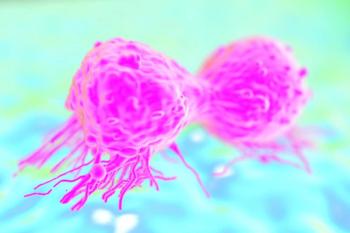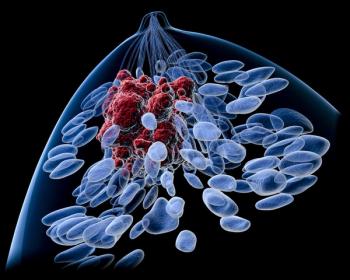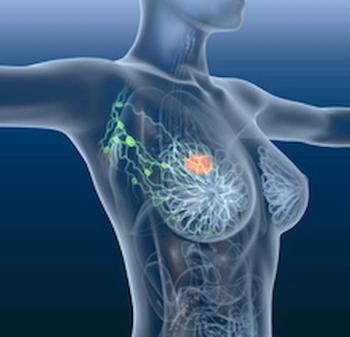
Oncology NEWS International
- Oncology NEWS International Vol 13 No 8
- Volume 13
- Issue 8
Breast Cancer Regimen Is Dose Dense, Dose Intense
NEW ORLEANS-A German study has provided more support for a dose-dense chemotherapy approach as adjuvant therapy for high-risk breast cancer. The investigators found improvements in
NEW ORLEANSA German study has provided more support for a dose-dense chemotherapy approach as adjuvant therapy for high-risk breast cancer. The investigators found improvements in disease-free and overall survival with sequential dose-dense therapy, compared with conventionally scheduled sequential chemotherapy. Speaking at the 40th Annual Meeting of the American Society of Clinical Oncology (abstract 513), Volker J. Möbus, MD, of Staedtisches Klinikum, Frankfurt, reported 28-month interim results from the multi-center phase III trial of the German AGO (Arbeitsgemeinschaft fuer Gynaekologische Onkologie) group. Dr. Möbus called the experimental regimen "dose intense" as well as "dose dense," as the individual doses were intensified and the drugs were given more frequently.
The study randomized 1,284 patients age 65 or less with four or more positive nodes to receive standard therapy with four courses of epirubicin (Ellence) (90 mg/m2) and cyclophosphamide (600 mg/m2), followed by four courses of paclitaxel (175 mg/m2) (EC→T) every 3 weeksor to three courses of sequential dose-dense/dose-intense chemotherapy using higher doses of epirubicin (150 mg/m2), paclitaxel (225 mg/m2), and cyclophosphamide (2,500 mg/m2) (ETC) every 2 weeks with G-CSF (Neupogen) support. Additional randomization in the dose-dense, dose-intense arm also evaluated patients with and without epoetin alfa support (Epogen, Procrit).
At a median follow-up of 28 months, with data available on 1,169 patients, significantly fewer patients in the sequential dose-dense arm had relapsed: 94 vs 127 with conventional therapy (P = .0009), for a relative risk reduction of 36%. For patients with 10 or more positive nodes, the relative risk reduction for relapse was 50%. The difference in relapse-free survival was highly significant, resulting in an estimated 3-year survival of 80% with dose-dense therapy vs 70% with standard therapy (P = .00009).
Mortality Rates
Mortality rates also favored the dose-dense arm, with 43 deaths with the dose-dense approach vs 60 with conventional therapy (P = .03), yielding an estimated 3-year overall survival of 90% vs 87%, respectively, Dr. Möbus reported.
The results appear to support those of the previous CALGB 9741 study, which showed a benefit for a dose-dense (every 2 week) schedule of doxorubicin/paclitaxel/cyclophosphamide, compared with a conventional every-3-week regimen in women with node-positive stage II/IIIa breast cancer. The new study, Dr. Möbus said, provides positive data from a second trial, thus potentially swaying oncologists to begin using the dose-dense regimen in their own practices.
Use of epoetin alfa improved tolerability of the dose-dense regimen, and there were no differences in relapse-free or overall survival between the dose-dense patients receiving and not receiving epoetin alfa. While red blood cell transfusions were necessary in 28% of the overall experimental arm, they were reduced to 12% in the group randomized to receive epoetin alfa (P = .0001). "There was a preventive effect of epoetin alfa for anemia," he said.
Hematological toxicity was more frequent in the dose-dense arm, with the highest incidence seen during treatment with cyclophosphamide and lowest with paclitaxel. Febrile neutropenia requiring hospitalization occurred in 7% with dose-dense therapy vs 2% with conventional therapy. There were no treatment-related deaths during therapy.
Discussant
Discussant Antonio C. Wolff, MD, of the Sidney Kimmel Comprehensive Cancer Center at Johns Hopkins Medical Center, commented: "This was a large study with promising interim data, but if confirmed, I’m not sure exactly what worked. Was it the frequency of the schedule, the intensification of individual doses, or both? And if this trial recapitulates CALGB 9741, which demonstrated value in densification without escalation, is dose intensification in addition to dose densification needed, and are there concerns about long-term toxicities?"
Articles in this issue
over 21 years ago
Benefits of SLN Biopsy Upheld in Large Trialover 21 years ago
Gemcitabine/Taxol: Another New Standard in Metastatic Caover 21 years ago
Statins Cut Colon Ca Risk in Half in Retrospective StudyNewsletter
Stay up to date on recent advances in the multidisciplinary approach to cancer.

















































































